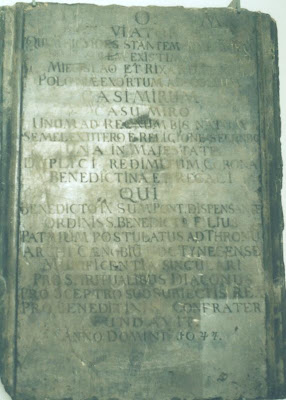This is a village famous for the obscene chalk figure cut into a hill nearby. The church is much less of a tourist attraction, but a calligraphy enthusiast may want to have a glance there - its walls are covered in quotations from the Bible written in blackletter calligraphy. Some inscriptions are dated 1679 and others 1701, which means it is baroque calligraphy, a result of an iconoclastic movement which made a sort of a cultural revolution in England. For a few years bands of angry Puritans went from village to village, entered churches and destroyed images. Churches were decorated in calligraphy afterwards, but the Cerne Abbas example shows that real artists were hard to find. The Cerne Abbas inscriptions are of poor quality, a far cry from what was produced at the same time in East Germany.
Calligraphy in old churches and other places as seen during cycling tours around Europe.
Wednesday, February 22, 2012
Sunday, February 12, 2012
Bath
An ancient city, it was already a spa in Roman times. Today the Roman baths are the main tourist attraction. The little museum by the baths contains some tombstones with fine Roman calligraphy. Some are written in the classical Capitalis Quadrata, others in a similar, but slightly narrower style, that might perhaps be termed Capitalis Rectangularis.
Tuesday, February 7, 2012
Benedictine Monastery in Tyniec
The Benedictine monastery in Tyniec (pron. Tyhnyets) stands on an isolated hill overlooking Vistula river. It is one of the oldest monastic establishments in Poland. The oldest part of the extant buildings are the cloisters; some Gothic textura inscriptions are visible there on the wall. Its present church is Baroque in style, one can see there some wall inscriptions in italics from the period. Artistically the best is, however, capitalis elegans from some epitaphs.
Wednesday, February 1, 2012
A monument of a deer in Briesen
Briesen is a little town in East Germany, not far to the East of Berlin. The monument of a deer stands actually in a forest near the town. It comemorates a hunt of one of the rulers of Brandenburg. There is a date of the event within the inscription, so one may gather that the date of the inscription itself is aproximately the same.
Subscribe to:
Posts (Atom)









